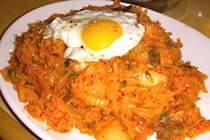Selection and storage
Leafy greens such as Napa cabbage are susceptible to pests. Conventionally grown Napa cabbage may have been treated with insecticidal sprays. Therefore, it is essential to thoroughly wash them in cold running water, followed by soaking them in saline water for approximately 30 minutes. Rinse them again in clean water before cooking.
When purchasing from the grocery store, seek out fresh, crispy, and compact Napa cabbage. Avoid those with yellow, dry, worm-infested, or old stalks.
At home, store Napa cabbage similarly to other greens, inside the refrigerator set at high relative humidity. It is optimal to use it while still farm-fresh to preserve maximum nutrients.
Preparation and serving tips
To begin, trim the base of the vegetable and discard any outer, discolored leaves. Submerge the entire vegetable in cold water and wash it thoroughly. After washing, either gently pat it dry or let it drain upside down until all the water has drained out.
For preparation, trim the base with a paring knife and then use your hands to separate the leaves from the stalk. Once the leaves are detached, they can be utilized in various recipes, either combined or individually.
In Far-Eastern regions, the average person consumes approximately a pound of fresh leafy-cabbage class vegetables daily, whether in the form of raw greens, in stews, or pickled (kimchi).
Here are some of the preparation tips:

|
| Korean kimchi fried rice! Photo courtesy: LWY |
-
Sweet, crunchy, and flavorful Chinese cabbage can be enjoyed raw and added to salads, sandwiches, and burgers.
-
Similar to other cabbage varieties, napa cabbage can also be used to make coleslaw.
-
Napa cabbage, also known as “pe-tsai,” is a popular ingredient in Korean fermented dish, kimchi.
-
In Thailand and other East Asian countries, shredded napa cabbage is steamed with rice wrapped in plantain leaves and served alongside stews.
-
In China and other East Asian regions, it is utilized similarly to cabbage in stir-fries, combined with onion, garlic, bell pepper and green chilies. This mixture is often paired with steamed rice and sauces like soy, chili, or tomato to create dishes such as fried rice, egg rice noodles, or chow mein.
-
Both bok choy and napa cabbage are versatile vegetables commonly used in modern stir-fries, soups, and stuffing.
Safety profile
Just like other vegetables belonging to the Brassica family, Napa cabbage contains specific chemical compounds referred to as “goitrogens.” Continual intake of vegetables from the Brassica group might cause enlargement of the thyroid gland, a condition termed goiter. Hence, it’s recommended to restrict Brassica vegetables in the diet of individuals with thyroid issues. Nonetheless, they pose no concerns for consumption by healthy individuals. (Medical disclaimer).
You may also like to read ≻≻
-
≺≺ Mizuna Nutrition facts.
-
≺≺ Komatsuna Health benefits.
-
≺≺ Chinese broccoli (Gai lan) Health benefits.
-
≺≺ Tatsoi (spoon mustard) Health benefits.
-
≺≺ Mustard-greens Health benefits.
≻≻-Back to Vegetables from Napa cabbage. Visit here for an impressive list of vegetables with complete illustrations of their nutrition facts and
health benefits.
≻≻-Back to Home page.
Further reading:
-
Stanford School of Medicine Cancer information Page- Nutrition to Reduce Cancer Risk. (Link opens in new window).

